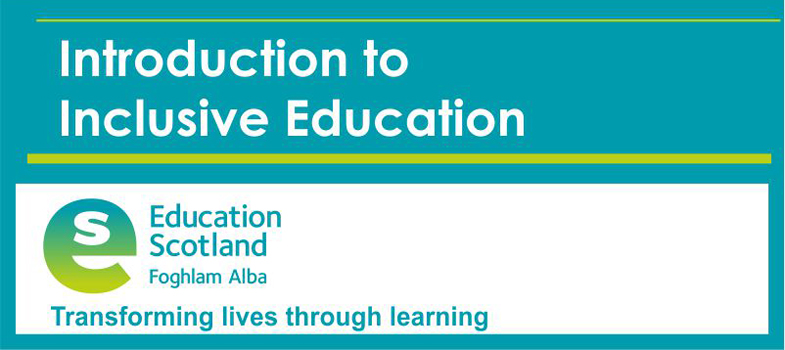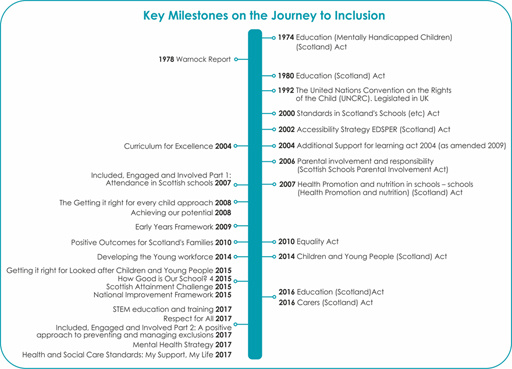1.2 Key Milestones on the Journey to Inclusion
Scottish education has come a long way since The Education (Mentally Handicapped Children)(Scotland) Act 1974 which declared every child was ‘educable’. Since then a range of policy and legislation has been introduced that supports inclusion. Figure 3 is a time line which provides an overview of the key milestones which underpin the journey to inclusion in Scotland.
As figure 3 highlights there have been a number of significant and notable developments which have contributed to providing an inclusive educational experience for all our learners in Scotland, a selection of which have been highlighted below.
You will need to download this file
Download Key Milestones on the Journey to Inclusion [Tip: hold Ctrl and click a link to open it in a new tab. (Hide tip)]
The United Nations Convention on the Rights of the Child (UNCRC).
This was brought into UK law in 1992 and is a legally-binding international agreement setting out the civil, political, economic, social and cultural rights of every child, regardless of their race, religion or abilities. The UNCRC consists of 54 articles that set out children’s rights and how governments should work together to make them available to all children.
Two particularly relevant articles with regards to inclusion are Articles 23 and 29.
Article 23 states that assistance to a disabled child should ‘ensure that the disabled child has effective access to and receives education…in a manner conducive to the child’s achieving the fullest possible social integration and individual development’.
Article 29 covers a range of factors which contribute to education. It states that the education of the child shall be directed to the development of the child’s personality, talents and mental and physical abilities to their fullest potential. It should also build their respect for other people and the world around them.
The UNCRC is the only international human rights treaty to give non-governmental organisations (NGOs), like Save the Children, a direct role in overseeing its implementation, under Article 45a. One of the Scottish Children’s Commissioner’s jobs is to make sure people in Scotland know about this convention.
Further information on the UNCRC can be found at https://www.unicef.org/ crc/
The Standards in Scotland’s Schools etc. Act (2000).
Every child or young person has the right and the entitlement to education, as detailed in this act. They have the right to be educated within mainstream education along with their peers and for education authorities to have due regard to their views in decisions that affect them. Local authorities, with their partners, have a duty within the Standards in Scotland’s Schools etc. Act (2000) to ensure that ‘education is directed to the development of personality, talents and mental and physical abilities of the child or young person to their fullest potential.’ This wording deliberately reflects Article 29 1(a) of the UNCRC. This duty is for all children, regardless of whether they require additional support to reach their full potential. This Act includes a ‘presumption of providing mainstream education’ for all children except where education in a school other than a special school would:
- not be suited to the ability or aptitude of the child;
- be incompatible with the provision of efficient education for the children with whom the child would be educated; or
- result in unreasonable public expenditure being incurred which would not ordinarily be incurred.
It will always be necessary to tailor provision to the needs of the individual child and the Act recognises there is a need to make available a range of mainstream and specialist provision, including special schools, to ensure the needs of all pupils and young people are addressed.
The Act also places education authorities under duties to provide education elsewhere than at a school where a pupil is unable to attend school due to ill health, and to make provision to provide education where a pupil is excluded from school.
Education (Disability Strategies and Pupils’ Educational Records) (Scotland) Act 2002
This Act requires education authorities (Responsible bodies) to develop and publish an accessibility strategy covering a 3 year period. This strategy must include setting out how the authority will increase learners’
- access to the curriculum,
- access to the physical environment of schools and
- improve communication with learners with disabilities
Education (Additional Support for Learning) (Scotland) Act 2004 (as amended by the Education (Additional Support for learning)(Scotland) Act 2009;
The Education (Additional Support for Learning) (Scotland) Act 2004 and amendments made in 2009 (ASL) Act provide the legal framework for assessment. However, no particular model of assessment or support is prescribed in "the ASL Act". This ASL Act requires Education Authorities to:
- Identify and assess children and young people with additional support needs
- Provide for the additional support required for each child or young person with additional support needs for whose education they are responsible, subject to certain exceptions
- Review the additional support needs identified and the adequacy of support provided to meet the needs of each child or young person
- Prepare a co-ordinated support plan for those children or young people who meet certain criteria and keep this plan under regular review
The ASL Act provides the legal framework for identifying and addressing the additional support needs of children and young people who face a barrier, or barriers, to learning. Children and young people have additional support needs when they require additional support in order to benefit from school education. Under the ASL Act young people are those over school age but who have not yet attained the age of eighteen. Parents, children and young people have certain rights under the ASL Act.
Education authorities are required to identify the additional support needs of each child or young person for whose school education they are responsible and the ASL Act requires certain other agencies to provide help where this is requested.
Code of Practice to support the ASL ACT
Supporting Children’s Learning: Statutory Guidance on the Education (Additional Support for Learning) Scotland Act 2004 (as amended) - Code of Practice (Third Edition) 2017
The Code of Practice is designed to help schools, parents and others to understand the ASL Act and ensure its implementation. This is the third edition of the code and replaces all previous versions. It takes account of the amendments in the Education (Scotland) Act 2016 (the Act) which extended certain rights to children aged 12 -15 years and who have capacity, (these were already in place for 16 year olds) and it explains the duties on education authorities and other agencies to support children’s and young people’s learning. The code provides guidance on the additional support for learning legislation and the supporting framework of secondary legislation.
Education authorities and appropriate agencies, such as NHS Boards, are under a duty to have regard to the code when carrying out their functions under the Act. The code is designed to help them make decisions effectively but cannot be prescriptive about what is required in individual circumstances.
The Equality Act 2010
The Equality Act 2010 places a duty on schools and Education Authorities to eliminate unlawful discrimination, harassment and victimisation of learners with protected characteristics, including disability, sexual orientation and ethnicity and to actively promote equality of opportunity.
The duties of the Equality Act 2010 (commenced 1 October 2010) require responsible bodies to actively deal with inequality, and to prevent direct disability discrimination, indirect disability discrimination and discrimination arising from disability and harassment or victimisation of pupils on the basis, or a perceived basis, of protected characteristics, including disability. The provisions include:
- Prospective pupils
- Pupils at the school
- In some limited circumstances, former pupils
In addition, under the Equality Act 2010 responsible bodies have a duty to make reasonable adjustments for disabled pupils and provide auxiliary aids and services. The duty is ‘to take such steps as it is reasonable to have to take to avoid the substantial disadvantage’ to a disabled person caused by a provision, criterion or practice applied by, or on behalf of, a school or by the absence of an auxiliary aid or service. (Commenced 1st September 2012)
What is disability?
It is helpful to understand what the term disability means. A person has a disability for the purposes of the Equality Act if he or she has a physical or mental impairment and the impairment has a substantial and long-term adverse effect on his or her ability to carry out normal day-to-day activities.
This means that, in general:
• The person must have an impairment that is either physical or mental;
• The impairment must have adverse effects which are substantial;
• The substantial adverse effects must be long-term; and
• The long-term substantial adverse effects must be effects on normal day-to-day activities.
All of the factors above must be considered when determining whether a person is disabled.
The Children and Young People (Scotland) Act (2014)
The Children and Young People (Scotland) Act (2014) places a duty on local authorities and schools to ensure the wellbeing of children and young people is safeguarded, supported and promoted. This has been an important addition to inclusive education legislation because the experience of the child or young person and the extent to which they feel included impacts on their wellbeing. The voice of the child or young person is essential in understanding their needs and ensuring their wellbeing is safeguarded, supported and promoted. Fostering strong relationships between staff and children and young people is essential to this practice.
The Getting it right for every child approach has been national policy since 2010 and is now defined in statute in the Children and Young People (Scotland) Act (2014). The Act aims to strengthen children’s rights and improve and expand services that support children and families, including looked after children. Its purpose is to ensure an inter-agency approach across education, health and social work to improve outcomes for children and young people.
Education (Scotland) Act (2016)
The Act introduces measures to improve Scottish education and reduce pupil’s inequality of outcomes. The Act includes provisions for strategic planning in order to consider socio-economic barriers to learning.
As outlined above the Act makes amendments to the Additional Support for Learning Act which extends the rights of children of 12 – 15 years and over who have capacity. Children who are able to, can also exercise their rights on their own behalf, to affect decision making about them. Also included and introduced within the Act are:
- Provisions on widening access to Gaelic medium education and streamlining of the process of making a complaint to Scottish Ministers.
- The National Improvement Framework (NIF) and amendments to the Standards in Scotland’s Schools etc. Act 2000, the Education (Additional Support for Learning) (Scotland) Act 2004, the Education (Scotland) Act 1980 and the Welfare Reform Act 2007.
As part of the preparation for the implementation of the Act, information for parents was developed. This explains all of the provisions of the Act. Page 6 sets out information on Additional Support for Learning changes which came into force in January 2018.
You will need to download this file
Download Children’s rights overview
You will need to download this file
Legislative and policy framework

